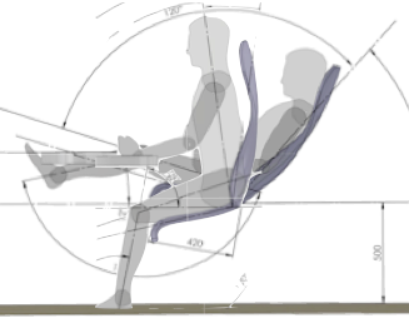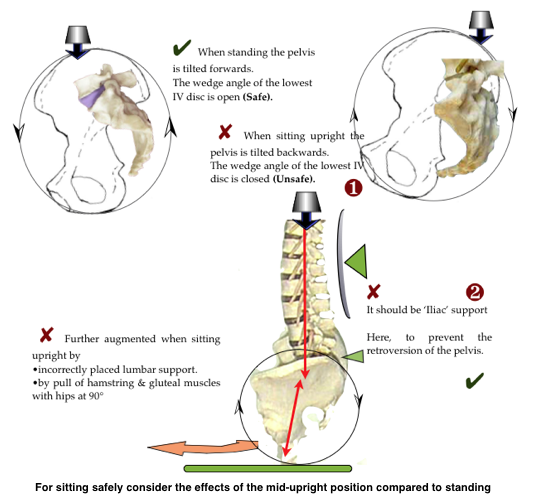THE OPTIMUM SITTING POSITION FOR PROLONGED WORK.
- Why has it taken so long to design a chair that addresses all the factors that may account for backache (LBP) on prolonged sitting?
- Is it that the full solution indicates a chair that looks too strange?
- It suggests that office workers in the future may be in a reclined position most of the time or walking about.
- This conclusion is derived from scientific work on :-
☛Spinal anatomy, ☛pathology & ☛paleoanthropology
☛Spinal biomechanics
and 50 years of experience
And has resulted in a 2Tilt chair solution
When first advanced 1n 1998 it was viewed with complete incomprehension by chair designers and manufacturers. Now, in 2015, they say “We agree,but ….” . Familiarity bias rules!
Once the main adverse effects of upright sitting are recognised then it becomes possible to consider the options available for remediation. This is a resource for the design of chairs to avoid the associated LBP. It should be an essential tool for any chair designer.
The adverse effects of upright sitting
These adverse biomechanical factors have to be addressed to ensure a sitting position that is the least likely to perpetuate, or result in, LBP and other symptoms. The obvious, and perhaps only, solution was for prolonged work to be performed in a chair that has a stable, correctly supported, supine reclined mode.
The 2 TILT chair CONCEPT.
The 2 Tilt (2T) chair concept is derived from the existing scientific work, already enumerated, to optimise the bio-mechanical spinal requirements for prolonged sitting.
 •Biomechanics suggest that a correctly configured reclined, relaxed, mode is the optimum for prolonged sedentary work. The 2T reclined mode→
•Biomechanics suggest that a correctly configured reclined, relaxed, mode is the optimum for prolonged sedentary work. The 2T reclined mode→
•This requires a 2nd upright mode for certain short tasks. Hence the 2T concept. Upright modes→
•The intermediate positions should be unstable and easily negotiated. The unstable intermediate mode→
This leads on to the 2T ‘deskless’ chair or work-station.
Advantages
- Reduced office footprint.
- 2T requirements easier to achieve.
And some considerations :-
•☛ Adjustments?→
•☛ Comfort?→
•☛ Criticism →
RECAPITULATION & selling points
A technical ‘fix’ is required if the increase in spinal morbidity and cost to industry of absenteeism and stress due to LBP is to be halted.
- For a quick overview of the subject for non-specialists.
- Western societies are unique in adopting, relatively recently (200 years), the mid-upright chair for everyday sedentary work.
- More recently there has been a reduction of exercise and horse-back riding.
- The increase in Low Back Pain (LBP) has mirrored these changes.
- This results in personal morbidity, loss of earnings and huge cost to industry.
- The mid-upright sitting position details seem to have been codified in the 1920s as a result of a false premise (see the account of Mandal AC. The Seated Man. Dafnia Publications. Denmark; 1985). It continues to be accepted as ‘correct’.
- Recent scientific work on spinal pathology and biomechanics show that these ‘correct’ details are flawed and seriously adverse to spinal well being. Pressure studies of spinal loading show that upright sitting itself may be adverse. The mid-upright mode also carries other marked defects, such as backward tilting of the pelvis, which are accentuated if the 90° hip angle (seat parallel to floor) or if lumbar (as opposed to iliac) support is incorporated.
- At present many work chairs can be unkindly designated as ‘Machines for making Backache’. A technical ‘fix’ is required if the increase in spinal morbidity, and cost to industry of absenteeism and stress due to LBP is to be halted.
- The biomechanical imperatives show that a safe chair can easily be achieved with the ‘2 Tilt principle’.
See For designers,manufacturers & office managers→

